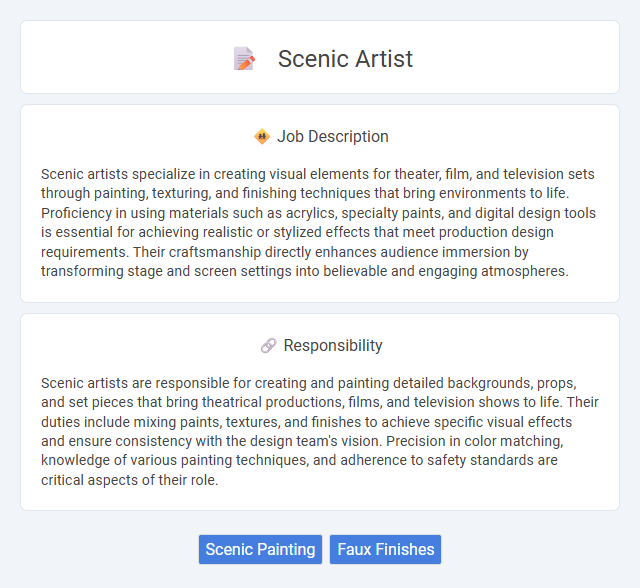
Scenic artists specialize in creating visual elements for theater, film, and television sets through painting, texturing, and finishing techniques that bring environments to life. Proficiency in using materials such as acrylics, specialty paints, and digital design tools is essential for achieving realistic or stylized effects that meet production design requirements. Their craftsmanship directly enhances audience immersion by transforming stage and screen settings into believable and engaging atmospheres.
Individuals with a strong passion for art and attention to detail are likely to find the role of a scenic artist suitable, especially if they enjoy working behind the scenes in creative environments. Those comfortable with physically demanding tasks and able to work on deadlines may have a higher probability of thriving in this profession. People who prefer solitary work or lack patience for meticulous artistic processes might find this job less fitting.
Qualification
Scenic artists must possess strong skills in painting, drawing, and design, often supported by a degree or certification in fine arts, theater production, or related fields. Proficiency in color theory, texture creation, and knowledge of various painting techniques is essential for producing realistic and artistic backdrops and props. Experience with set construction and the ability to collaborate closely with directors and designers are highly valued qualifications for this role.
Responsibility
Scenic artists are responsible for creating and painting detailed backgrounds, props, and set pieces that bring theatrical productions, films, and television shows to life. Their duties include mixing paints, textures, and finishes to achieve specific visual effects and ensure consistency with the design team's vision. Precision in color matching, knowledge of various painting techniques, and adherence to safety standards are critical aspects of their role.
Benefit
Scenic artists likely enjoy a variety of benefits, including the opportunity to express creativity while contributing to visually captivating productions. They may experience job satisfaction from transforming ideas into immersive environments that enhance storytelling in theater, film, and television. The role often provides chances for skill development in painting, design, and collaboration with diverse artistic teams.
Challenge
Scenic artist roles often involve the challenge of creating visually compelling and realistic environments under tight deadlines and budget constraints. The probability of encountering complex textures, intricate details, and unconventional materials requires strong problem-solving skills and adaptability. Navigating these artistic and logistical challenges may significantly impact the final production quality and audience immersion.
Career Advancement
Scenic artists specialize in creating visual backgrounds and set designs for theater, film, and television, utilizing skills in painting, drawing, and design to bring artistic concepts to life. Career advancement in this field often involves progressing from entry-level painting roles to lead scenic artist or scenic art supervisor positions, where professionals oversee teams and manage complex projects. Developing expertise in digital design tools and building a strong portfolio can lead to opportunities in production design or art direction, expanding career prospects within the entertainment industry.
Key Terms
Scenic Painting
Scenic artists specialize in scenic painting, creating detailed backdrops, props, and set pieces for theater, film, and television productions. Their expertise includes mastering various painting techniques such as trompe-l'oeil, faux finishes, and texture replication to bring realistic or imaginative environments to life. Proficiency in color theory, surface preparation, and collaboration with designers enhances the visual storytelling and immersive experience on stage or screen.
Faux Finishes
Scenic artists specializing in faux finishes create realistic textures and surfaces on stage sets, using techniques such as sponging, marbling, and trompe-l'oeil to enhance visual storytelling. Mastery of paint layering, color mixing, and surface preparation is essential for producing durable and convincing effects that transform plain materials into intricate designs. Expertise in faux finishes contributes significantly to immersive theater experiences by adding depth and authenticity to the scenic environment.
 kuljobs.com
kuljobs.com